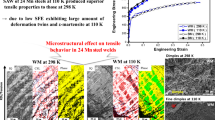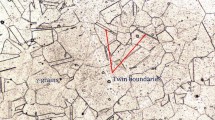Abstract
The ITER magnet system is based on the “cable-in-conduit” conductor (CICC) concept, which consists of stainless steel jackets filled with superconducting strands. The jackets provide high strength, limited fatigue crack growth rate and fracture toughness properties to counteract the high stress imposed by, among others, electromagnetic loads at cryogenic temperature. Austenitic nitrogen-strengthened stainless steels have been chosen as base material for the jackets of the central solenoid and the toroidal field system, for which an extensive set of cryogenic mechanical property data are readily available. However, little is published for their welded joints, and their specific performance when considering different combinations of parent and filler metals. Moreover, the impact of post-weld heat treatments that are required for Nb3Sn formation is not extensively treated. Welds are frequently responsible for cracks initiated and propagated by fatigue during service, causing structural failure. It becomes thus essential to select the most suitable combination of parent and filler material and to assess their performance in terms of strength and crack propagation at operation conditions. An extensive test campaign has been conducted at 7 K comparing tungsten inert gas (TIG) welds using two fillers adapted to cryogenic service, EN 1.4453 and JK2LB, applied to two different base metals, AISI 316L and 316LN. A large set of fracture toughness data are presented, and the detrimental effect on fracture toughness of post-weld heat treatments (unavoidable for some of the components) is demonstrated. In this study, austenitic stainless steel TIG welds with various filler metals have undergone a comprehensive fracture mechanics characterization at 7 K. These results are directly exploitable and contribute to the cryogenic fracture mechanics properties database of the ITER magnet system. Additionally, a correlation between the impact in fracture toughness and microstructure resulting from the above treatment is provided.









Similar content being viewed by others
References
The ITER project, European Fusion Development Agreement (EFDA) (2006)
Sborchia C. et al, Overview of ITER Magnet System and European Contribution, in 2011 IEEE/NPSS, 24th Symposium on Fusion Engineering
N. Mitchel et al., The ITER Magnets: Design and Construction Status, IEEE Trans. Appl. Supercond., 2012, 22(3), p 4200809
W.S. Pellini, Guidelines for Fracture-Safe and Fatigue-Reliable Design of Steel Structures. Applications of Fracture Mechanics and Structural Integrity Technology, Welding Institute, Cambridge, 1983
S.T. Rolfe and J.M. Barsom, Fracture and Fatigue Control in Structures: Applications of Fracture Mechanics, ASTM International, West Conshohocken, 1977
T.L. Anderson, Fracture Mechanics: Fundamentals and Applications, 3rd ed., CRC Press, Boston, 2005
J.R. Rice, A Path Independent Integral and the Approximate Analysis of Strain Concentration by Notched and Cracks, Journal of Applied Mechanics, 1968, 35, p 379–386
V. Shankar, T.P.S. Gill, S.L. Mannan, and S. Sundaresan, Solidification Cracking in Austenitic Stainless Steel Welds, Sadhana, 2003, 28(3–4), p 359–382
J.A. Brooks and A.W. Thompson, Microstructural Development and Solidification Cracking Susceptibility of Austenitic Stainless Steel Welds, International Materials Reviews, 1991, 36(1), p 16–44
ASTM E45-13, Standard Test Methods for Determining the Inclusion Content of Steel.
R.P. Walsh, V.J. Toplosky, K. Han, N.N. Martovetsky, T. Mann, and J.R. Miller, Mechanical Properties of Modified JK2LB for Nb 3 Sn CICC Applications, CEC-ICMC, Tucson (Arizona), 2009
H. Nakajima et al., Development of Low Carbon and Boron Added 22Mn–13Cr–9Ni–1Mo–0.24N Steel (JK2LB) for Jacket which Undergoes Nb3Sn Heat Treatment, Trans. Appl. Superconduct., 2004, 14(2), p 1145–1148
K. Hamada et al., Optimization of JK2LB Chemical Composition for ITER Central Solenoid Conduit Material, Cryogenics, 2007, 47(3), p 174–182
ISO 15614-1:2004—Specification and qualification of welding procedures for metallic materials—Welding procedure test—Part 1: Arc and gas welding of steels and arc welding of nickel and nickel alloys.
ISO 6947:2011—Welding and allied processes—Welding positions.
ISO 4063:2009—Welding and allied processes—Nomenclature of processes and reference numbers.
ASTM E1820:01—Standard Test Method for Measurement of Fracture Toughness.
ASTM E1823—Standard Terminology Relating to Fatigue and Fracture Testing
K. Iida and A.J. McEvily, Ed., Advanced Materials for Severe Service Applications, Springer, Berlin, 2012
X.-K. Zhu and J.A. Joyce, Review of Fracture Toughness (G, K, J, CTOD, CTOA) Testing and Standardization, Engineering Fracture Mechanics, 2012, 85, p 1–46
S. Kuimalee et al., Isothermal Phase Transformation Sequence in Fe–22wt%Cr–3.2wt%Mo–6.2wt%Ni–0.037%C Cast Duplex Stainless Steel, Chiang MaiJ. Sci., 2011, 38(1), p 47–55
Y. Song, T.N. Baker, and N.A. McPherson, A Study of Precipitation 316LN Precipitation in As-Welded 316LN Plate Using 316L/317L Weld Metal, Materials Science and Engineering: A, 1996, 212(2), p 228–234
Y. Zhou, Y. Liu, X. Zhou, C. Liu, J. Yu, Y. Huang et al., Precipitation and Hot Deformation Behavior of Austenitic Heat-Resistant Steels: A Review, J. Mater. Sci. Technol., 2017, 33, p 1448–1456
V.D. Vijayanand, K. Laha, P. Parameswaran, V. Ganesan, and M.D. Mathew, Microstructural Evolution During Creep of 316LN Stainless Steel Multi-pass Weld Joints, Materials Science and Engineering: A, 2014, 607, p 138–144
Acknowledgments
The authors would like to express their thanks to Dr. Arman Nyilas (in memorian) for the contributions made in this work.
Author information
Authors and Affiliations
Corresponding author
Rights and permissions
About this article
Cite this article
Aviles Santillana, I., Boyer, C., Fernandez Pison, P. et al. A Comparative Study of Fracture Toughness at Cryogenic Temperature of Austenitic Stainless Steel Welds. J. of Materi Eng and Perform 27, 1995–2002 (2018). https://doi.org/10.1007/s11665-018-3266-1
Received:
Revised:
Published:
Issue Date:
DOI: https://doi.org/10.1007/s11665-018-3266-1




